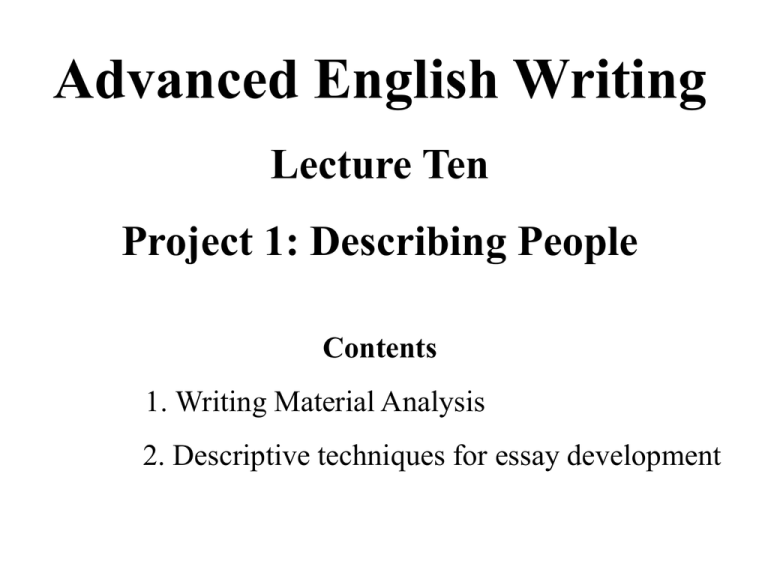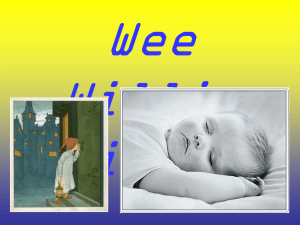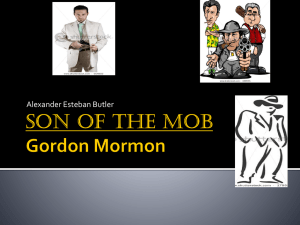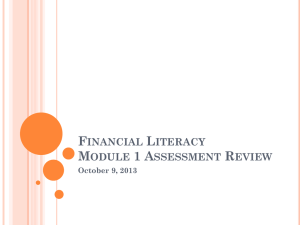Writing Material Analysis
advertisement

Advanced English Writing Lecture Ten Project 1: Describing People Contents 1. Writing Material Analysis 2. Descriptive techniques for essay development • Practice 1: Last week you found a mobile phone in a classroom on campus. Lucky for the loser, you’re an honest person and you want to return it. The problem is that the phone’s battery is dead, so you’re unable to contact the owner. Yesterday, by chance, you saw the sign below posted in the student union building on your campus. You think this could be the owner, but you want to be absolutely sure. Work with a partner and think of some questions you might ask this person. One example has been done for you. e.g. What color is it? Help Me! I’m a poor college student and I’ve lost my mobile phone… Are the questions listed there the same as the ones you chose? Are there any you didn’t consider? •How old is it?/ What year was it made? •How big is it? •What shape is it?/ What is its shape? •What does it look like? / Can you describe what it looks like? •What kind of phone is it?/ What is the brand name? •Does it have any distinguishing marks? •Can you call the mobile now? •When did you lose it? •Exactly where did you lose it? Practice 2: at the sight of this picture, what appears in your mind? Write down as many words to describe this man as possible. Word Wheels Practice 3: The following are some words someone has chosen to describe Fela Kuti, a musician from Nigeria. One problem is that he mistakenly uses some nouns instead (do you have the same problem in your work?) Identify which is used in the word wheel below, writing an N if it’s a noun and an A if it’s an adjective. If it’s a noun, write the adjective form next to it, and vice-versa (some words may not have a noun or adjective form). perseverance confrontation=N/ confrontational=A reckless rebel fearlessness enlightened brilliance non-conformist boisterousness complexity wild Word Wheels confrontation=N/ confrontational=A perseverance=N/ persevering=A rebel=N/ rebellious=A reckless=A/ (no noun form) fearlessness=N/ fearless=A enlightened=A/ enlightenment=N brilliance=N/ brilliant=A non-conformist=N/ nonconforming=A boisterousness=N/ boisterous=A complexity=N/ complex=A wild=A/ (no noun form) Developing Your Vocabulary Practice 4: with a partner, list out as many adjectives that describe the following aspects as possible. Use a dictionary to help you find adjectives that are vivid, not boring. Adjectives Used to Describe Human Physical Appearance Adjectives Used to Describe Personality Traits Adjectives Used to Describe Objects Adjectives Used to Describe Food and Drink Adjectives Used to Describe Human Physical Appearance Slender 苗条的 stocky 矮壮结实的 Chubby 丰满的 overweight Robust 精力充沛的 well-built 体格健美的 Muscular 肌肉强健的 Burly 魁伟结实的 Obese 肥胖的 Trim 整洁的 Petite 小巧玲珑的 Stunning 晕厥极好的 striking 有吸引力的 dazzling 耀眼的 attractive unattractive elegant 文雅,端庄的 Scrawny 骨瘦如柴的 skinny Boney 瘦骨嶙峋的 average-looking plain Neat 灵巧,优雅的 Tidy 整洁的 well-dressed gorgeous tall Squat 粗短的 Adjectives Used to Describe Personality Traits Bold 大胆的 Shallow 浅薄的 Reckless 不计后果的 Accomplished 多才多艺的 unique simple-minded 头脑简单 annoying 恼人的 Inept 无能的,不称职的 Enthusiastic 热心的 Green 无经验的 Witty 机智诙谐的 Clumsy 笨拙的 Excitable 易激动的 Fragile 脆弱的 Sharp 精明锐利的 Informed 见多识广的 Realistic 现实主义的 Frail 脆弱的 Dull 迟钝呆滞的 uninformed Unrealistic Cautious 小心谨慎的 Reliable 可靠的 Boisterous 狂暴的 Jumpy 活跃,神经质 Considerate 周到的 unreliable Conscientious 尽责的 Jittery 战战兢兢的 understanding Sentimental 感情脆弱的 Graceful 优美的 Weird 怪异的 Contentious 好争斗 Rebellious 叛逆的 Elegant 文雅端庄的 Odd 奇怪的 Touchy 暴躁的 sweet Deep 诡计多端的 Adjectives Used to Describe Personality Traits Cocky 骄傲自大 的 quick-tempered 性急 的 child-like 天真烂漫 的 sophisticated 久经世故 的 adventurous even-tempered 冷静 的 lovable Cultured 有教养的 Suspicious 可疑的 Composed 沉着的 Approachable 平易 近人 Enlightened 文明的 Conservative 保守 Admirable 令人钦佩 的 的 Engaging 动人的 Aggressive 好斗的 Liberal 自由主义 的 Brilliant 有才气的 Aloof 冷淡的 Courageous 勇敢的 wide-eyed Sociable 擅交际的 capable Impulsive 冲动的 grumpy 脾气暴躁 的 anti-social competent Obsessive 强迫性的 wild Outgoing 对人友好的 incompetent ordinary Gracious 亲切高尚的 Gifted 天才的 Industrious 刻苦的 Adjectives Used to Describe Objects Fragile 易碎的 out-of-date Worthless 无价值的 Petite 娇小的 cheap Obsolete 陈旧的 gorgeous Bulky 体积大的 Sturdy 强健的 old-fashioned huge unique durable state-of-the-art 艺术的 Humongous 极大的 Priceless 无价的 rare Treasured 珍贵的 gigantic uncommon Cherished 珍爱的 Immense 极大无边的 ordinary practical tiny Worthless 无价值 Fancy 奇特的,异样的 Miniscule小的 Adjectives Used to Describe Food and Drink Hearty 丰盛的 disgusting plain Succulent 多汁的 tasty bitter Savory 可口的,味美的 overcooked gross 肥大的 spicy undercooked yummy (slang/nonacademic) salty sweet Choosing a Topic What you choose to write about may be even more important than how you describe it. Consider your audience. Who is my reader? Does he want to read an essay about Yao Ming for the one hundredth time? Show your reader that you’ve given careful thought to your choice and aim for a creative subject that hasn’t been written about a thousand-and-one times. Do write about… Something new, different or out of the ordinary What you know A person, place or thing that your reader may be unfamiliar with. It is an excellent opportunity for you to teach Something exciting Don’t write about… Something that’s been written about a thousand times Something you know nothing about or that’s too complicated to explain A person, place or thing that says nothing new to your reader Tip! A strong description will include less common words and expressions. Include them in your writing, but be reasonable about how many of them you use. You shouldn’t try to impress your readers with big words— this is often counterproductive. Pick and choose a few areas to put more complex expressions in place of less common ones. Start with the words you feel most confident with and you should gradually introduce more into your writing. Don’t worry about making mistakes once your vocabulary base becomes larger. Writing is a process of trial and error. Fela Kuti Virtually unknown until recently outside of Africa, Fela Anikulapo Kuti (usually just called Fela) was born in 1938 in Nigeria, West Africa. A human rights activist, political rebel and social nonconformist, he is probably best known as the creator of a new musical genre called Afro Beat, a style that swept the continent in the early 1970s. But for a small cult of serious music enthusiasts, Fela's music has yet to be appreciated by a broader audience outside of his homeland. Relative to his adult years, Fela lived a rather uneventful upper-class childhood in Nigeria, In1958 his privileged background allowed him to go to London with the intention to study medicine. He soon became enamored with the city's thriving music scene instead and went on to study at Trinity College of Music where he formed his first hand. Koola Lobitos. He, along with esteemed drummer Tony Allen, would be the forbearers of a totally new sound: Afro Beat. Developed at the end of the 1960s, Afro Beat was a fusion of American Jazz, Funk, and several traditional and modern African styles. Most of these songs would last 10 to 30 minutes, with signature repetitive bass rhythms, wildly creative drum fills and long instrumental parts that usually involved interplay between the rhythm section, horns and guitars. Central to the music was an explicit message that addressed Nigerian, African and world issues. After spending time in the U.S. recording music with his band, by then renamed Africa 70, Fela returned to Nigeria. His music began taking a political tone and his target soon became the corrupt government and institutions of his native country. In response to what he felt was a dishonest and vicious military government, Fela formed his own republic, the Kalakuta Republic, on his spacious compound in the early 1970s. He declared the compound independent from Nigeria. By this time the boisterous and outspoken Fela had become the biggest star in West Africa. Throughout most of the next 20 years, he was constantly harassed by police and other government forces. He was jailed on several occasions, always under false pretenses. One instance in 1977 witnessed an invasion on his home, the Kalakuta Republic, by an estimated 1,000 soldiers. He was badly beaten and nearly killed. Worse, his 82-year-old mother was thrown from a window, later dying from the injuries. The Kalakuta commune was burned to the ground. Infuriated, Fela refused to back down, immediately writing songs verbally attacking the Nigerian government, even holding the Nigerian President personally responsible for his mother's death in one brilliantly conceived song titled, "Coffin for the Head of State." On the one year anniversary of the attack on the Kalakuta Republic, Fela continued his confrontational ways by marrying twenty-seven women in a nationally televised event. He did this in part as an act of disobedience against the social and political norms of Nigeria. In 1979 he decided to take power into his own hands, declaring his intention to run for President. The plan was unsuccessful, however, as the powers managed to curtail his political rise by proclaiming his nomination invalid, and he soon abandoned his ambitions. Fela's music production slowed considerably in the late 1980s, and by the mid1990s he stopped making music altogether. He was secretly gripped by an illness, the source of which may have been unknown at the time. The day after his death in 1997, it was revealed by his older brother that Fela had long been suffering from the AIDS virus. An estimated one million people attended his funeral. Writing Assignment In this assignment, you will write a paragraph of approximately 250 words that describes the personality of a close friend or relative. You will follow the steps of the writing process. Step 1: Free Writing Free write for ten minutes about the family member or close friend you choose to describe. Write as much as you can, without stopping. DO NOT worry about making mistakes. instead, put all your ideas on paper. • Exercise 2 Constructing a concept map In a concept map, the main idea is written in the center, and the major points with their supporting details are grouped around the main idea. Step 2: Constructing a concept map Lizbet used the ideas in her freewriting to construct a concept map as the follow: My cousin Jasmine is fun physically Socially Personally 1. Short 1. Lots of friends 1. Active 2. Great smile 2. outgoing 2. Very frank, but nice 3. Dark hair Step 3: Focusing your concept map Reread the assignment, and review your concept map. Then decide what the main idea about your family member or close friend should be. Revise your controlling idea if necessary. Cross out any information in your concept map that does not relate to the main idea you have selected. My cousin Jasmine is very friendly physically Socially Personally 1. Short 1. Lots of friends 1. Active 2. Great smile 2. outgoing 2. Very frank, but nice 3. Dark hair Step 4: Adding details to your concept map Lizbet added more specific details to the major points about Jasmine’s friendliness. She added specific physical details that showed Jasmine’s friendliness, specific social examples of friendliness, and specific personal information that showed her friendliness. My cousin Jasmine is fun Physically •great smile •people always comment on her smile, even when they just see her photo socially •Lots of friends/ outgoing •Works successfully as a receptionist •Goes out 4 or 5 times a week with friends personally •Very frank, but nice •Telling the truth but doesn’t hurt feelings •If someone is late, she doesn’t scold. She says “Are you all right? I was a little worried Step 5: Filling in an outline Lizbet used the information that she had gathered and organized to write a first draft to her paragraph. 1) My cousin Jasmine is an open and friendly person who is liked by others. 2) She is successful in her job as a receptionist because she is outgoing. 3) She welcomes clients and answers the phone warmly. 4) Jasmine has lots of friends and she goes out four or five times a week. 5) Her friends say that they like Jasmine because she ahs such a great smile. 6) People always comment on it, even when they just see her photo. 7) Another reason she is so popular is that she always tells the truth, but she does it nicely. 8) For example, if a friend arrives very late, she does not scold the friend. 9) Instead, she says, “Are you all right? I was a little worried.” 10) For all these reasons, Jasmine is one of the friendliest persons I have ever know. Step 5: Filling in an outline Complete the outline with information from your concept map Topic Sentence: ______________________________________________________ Major Point 1: _______________________________________________________ Specific Detail to support Major Point 1: _______________________________ ___________________________________________________________________ Major Point 2: _______________________________________________________ Specific Detail to support Major Point 2: _______________________________ ___________________________________________________________________ Major Point 3: _______________________________________________________ Specific Detail to support Major Point 3: ________________________________ ___________________________________________________________________ Concluding Sentence: ___________________________________________________________________ Step 6: Writing your first draft Step 7: Checking your writing Step 8: Doing a peer response Step 9: Revising your writing Different Types of Writings about People 1) Biography: subjects for biographies are usually public figures (Premier Zhou Enlai, JFK, Martin Luther King, Jr.); therefore, biographers rely on published documents, interviewing the subject (if he or she is still living) and people who know or knew the subject. 2) Autobiographers: Benjamin Franklin, for example write about their own lives even though they may include others who have somehow been involved in their lives; therefore the main source of data is their memory and their personal documents (old diaries, letters, and so forth) Different Types of Writings about People 3) Memoir: (one written by a bodyguard of the late Premier Zhou) usually presents an important person the writer once knew well, so it also relies heavily on memory and personal documents. 4) Reportage: (newspapers and magazines are full of them!) is usually written about an interesting or unusual individual and the writer relies on interviews and observation of that individual and others who know him or her. We are going to talk about essay-length( about five papers long, double space) writings about people we remember from the past. Writing Material Analysis Questions for Critical Thinking, Discussion, and Writing 1. Does it remind you of any of your childhood experience? Does anyone in your life somehow resemble Uncle Willie? Were you forced to learn something, e.g. to play certain music instruments (the piano, the violin, etc.)? Who in your family is more "strict" and who is "kinder, " your father or your mother? Why? Has your opinion of that more strict 'disciplinarian" in your family changed? Why and how? Writing Material Analysis Questions for Critical Thinking, Discussion, and Writing 2. Out of so many things that, happened during the years Angelou lived with her uncle, she chose only two anecdotes to write about, one in paragraph 2 and one in paragraphs 6 -18. Why? What does each anecdote tell us about Uncle Willie, and about Angelou herself? Why is the narrative of the first anecdote rather brief while the second is so elaborate? Writing Material Analysis Questions for Critical Thinking, Discussion, and Writing 3. What specific narrative action contributes to the vividness of the second anecdote? Does the dialogue catch the mood of the scene and the emotional state of Uncle Willie and young Angelou? Writing Material Analysis Questions for Critical Thinking, Discussion, and Writing 4. In paragraph 20, Angelou explains why Willie is tired of being crippled that particular day. Can you offer any additional or different explanation? Could it have anything to do with the fact that those two visitors from Little Rock are teachers? If you think so, can you cite any fact from the first part of the story to support yourself? Maya Angelou, a poet and autobiographer, grew up during the 1930s in the small Arkansas town of Stamps, where she lived with her brother Bailey, her grandmother (the "Momma" in this selection), and Uncle Willie who operated a small grocery store. “Uncle Willie” is excerpted from I Know Why the Caged Bird Sings (1970). Uncle Willie Maya Angelou When Bailey was six and I a year younger, we used to rattle off the times tables with the speed I was later to see Chinese children in San Francisco employ on their abacuses. Our summer-gray potbellied stove bloomed rosy red during winter, and became a severe disciplinarian threat if we were so foolish as to indulge in making mistakes. Brief Comment: Angelou doesn't simply tell why Uncle Willie is a significant person in her life: rather she shows it through vivid description of narrative action and dialogue. The opening is short but effective in arousing our interest: How would the kids be "disciplined" if they dare to make any errors? Uncle Willie used to sit, like a giant black Z (he had been crippled as a child), and hear us testify to the Lafayette County Training Schools' abilities. His face pulled down on the left side, as if a pulley had been attached to his lower teeth, and his left hand was only a mite bigger than Bailey's, but on the second mistake or on the third hesitation his big overgrown right hand would catch one of us behind the collar, and in the same moment would thrust the culprit toward the dui; red heater, which throbbed like a devil's toothache. We were never burned, although once I might have been when I was so terrified I tried to jump onto the stove to remove the possibility of its remaining a threat. Like most children, I thought if I could face the worst danger voluntarily, and triumph, I would forever have power over it. But in my case of sacrificial effort I was thwarted. Uncle Willie held tight to my dress and I only got close enough to smell the clean dry scent of hot iron. We learned the times tables without understanding their grand principle, simply because we had the capacity and no alternative. Brief Comment: We "see" a not so pleasant or flattering portrait of Uncle Willie, the subject of this narrative: He's sitting there "like a giant black Z," with his lopsided face, his tiny left hand and overgrown right hand. On top of that, he is a harsh, almost cruel "disciplinarian." We "see" the traumatizing, almost nightmarish experience for the five-year-old Angelou. Yet that negative feeling (both the author's and ours) would be more than counterbalanced by the picture of Uncle Willie that emerges from the second anecdote: a proud but vulnerable human being tired of fighting, at least for one day. The description may be somewhat exaggerated, but it is certainly accurate in showing what was going on in the fertile mind of a five-ear-old, full of imagination yet scared to death. The tragedy of lameness seems so unfair to children that they are embarrassed in its presence. And they, most recently off nature's mold, sense that they have only narrowly missed being another of her jokes. In relief at the narrow escape, they vent their emotions in impatience and criticism of the unlucky cripple. Momma related times without end, and without any show of emotion, how Uncle Willie had been dropped when he was three years old by a woman who was minding him. She seemed to hold no rancor against the baby-sitter, nor for her just God who allowed the accident. She felt it necessary to explain over and over again to those who knew the story by heart that he wasn't "born that way. " In our society, where two-legged, two-armed strong Black men were able at best to eke out only the necessities of life, Uncle Willie, with his starched shirts, shined shoes and shelves full of food, was the whipping boy and butt of jokes of the underemployed and underpaid. Fate not only disabled him but laid a double-tiered barrier in his path. He was also proud and sensitive. Therefore he couldn't pretend that he wasn't crippled, nor could he deceive himself that people were not repelled by his defect. Only once in all the years of trying not to watch him, I saw him pretend to himself and others that he wasn't lame. Coming home from school one day, I saw a dark car in our front yard. I rushed in to find a strange man and woman (Uncle Willie said later they were schoolteachers from Little Rock) drinking Dr. Pepper in the cool of the Store. I sensed a wrongness around me, like an alarm clock that had gone off without being set. I knew it couldn't be the strangers. Not frequently, but often enough, travelers pulled off the main road to buy tobacco or soft drinks in the only Negro store in Stamps. When I looked at Uncle Willie, I knew what was pulling my mind's coattails. He was standing erect behind the counter, not leaning forward or resting on the small shelf that had been built for him. Erect. His eyes seemed to hold me with a mixture of threats and appeal. I dutifully greeted the strangers and roamed my eyes around for his walking stick. It was nowhere to be seen. He said, "Uh .. this this ... this ... uh, my niece. She's ... uh ... just come from school. " Then to the couple — "You know ... how, uh, children are ... th-ththese days ... they play all d-d-day at school and c-c-can't wait to get home and pl-play some more." The people smiled, very friendly. He added, "go on out and pl-play, sister. " The lady laughed in a soft Arkansas voice and said, "Well, you know, Mr. Johnson, they say, you're only a child once. Have you children of your own?" Uncle Willie looked at me with an impatience I hadn't seen in his face even when he took thirty minutes to loop the laces over his high-topped shoes. "1 ... I thought I told you to go ... to out-side and play. " Before I left I saw him lean back on the shelves of Garret Snuff, Prince Albert and Spark Plug chewing tobacco. "No, ma'am ... no ch-children and no wife. " He tried a laugh. "I have an old m-m-mother and my brother's t-two children to I-look after. " I didn't mind his using us to make himself look good. In fact, I would have pretended to be his daughter if he wanted me to. Not only did I not feel any loyalty to my own father, I figured that if I had been Uncle Willie's child I would have received much better treatment. The couple left after a few minutes, and from the back of the house I watched the red car scare chickens, raise dust and disappear toward Magnolia. Uncle Willie was making his way down the long shadowed aisle between the shelves and the counter - hand over hand, like a man climbing out of a dream. I stayed quiet and watched him lurch from one side, bumping to the other, until he reached the coal-oil tank. He put his hand behind that dark recess and took his cane in the strong fist and shifted his weight on the wooden support. He thought he had pulled it off. I'll never know why it was important to him that the couple (he said later that he'd never seen them before) would take a picture of a whole Mr. Johnson back to Little Rock. He must have tired of being crippled, as prisoners tire of penitentiary bars and the guilty tire of blame. The high-topped shoes and the cane, his uncontrollable muscles and thick tongue, and the looks he suffered of either contempt or pity had simply worn him out, and for one afternoon, one part of an afternoon, he wanted no part of them. I understood and felt closer to him at that moment than ever before or since. Brief Comment: In the second anecdote, the writer uses dialogue extensive1y to help recreate the scene and reveal the mental and emotional state of Uncle Willie. It is possible that he stammers (while talking to the visitors) because of a speech impediment, but more importantly, the stammering shows he is not used to “pretending,” and he feels uncertain and vulnerable. The impact of this event on young Angelou is significant: a very observant (noticing something "wrong" right away) and sensitive young girl, she is willing to pretend to be his daughter and she now understands the uncle (and humanity?) much better.


![What_do_Fish_Have_to_Do_with_Anything[1]](http://s3.studylib.net/store/data/006629434_1-a00b1e75dfb71b3f93ad5805d2caa648-300x300.png)








